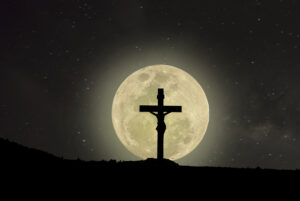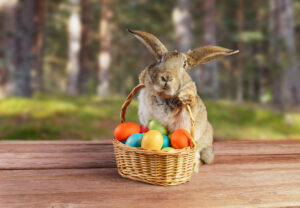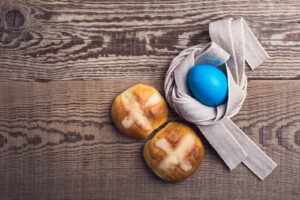We all know about Christmas and its origins and have had the Christmas story read to us dozens of times and the same could be said of the Easter story too but do we really know all about the traditions of Easter?
Activity One – When is Easter?
Suitable for Years R to 2
Learning Objectives:
To understand that the date of Easter is determined by the phases of the moon
To be able to use a calendar to estimate when Easter will fall from looking at the moon’s phases
To be able to read information from tables
This may all sound a little complicated for young children but it involves a little astronomy and some RE of a different religion so can be approached from different angles.
Judaism celebrates the Passover which commemorates the escape of the Jews from slavery in Egypt with the final ‘plague’, the death of the first born male child. Families who placed a mark made in blood on their doors were ‘passed over’ by the angel of death.
Jesus’ crucifixion and resurrection, the focal point of Easter, is said to have occurred around the time of the Passover which the Jews calculate as being the first full moon after the spring equinox (the day when day and night are the same length). Early Christians followed this idea, meaning that in the early years of the Christian church, Easter could be on any day of the week but was eventually fixed as being the first Sunday after the first full moon after the spring equinox.
For this activity, first tell the pupils that Easter is celebrated on different dates each year and can be any time between March 22nd and April 25th. Tell them that the date of Easter depends on the date of the full moon that comes after the date in spring when day and night are the same length – March 21st.
This website shows us the dates of all the full moons up to 2036 whilst on this page you can create a calendar for any year.
For each year, ask the pupils to find the first full moon after the 21st March in the moon phase charts then look at the calendar to find the date of the first Sunday after this date. That will be the date of Easter that year. The answer can be checked here.
Activity Two – The Easter Bunny
Suitable for Years Rec to 2+
Learning Objective:
To recognise that traditions play a large part in celebrations
To understand the significance of the Easter Bunny in other cultures
The Easter Bunny may seem like a marketing ploy or the imagination of a Hollywood animator but the origins of the Easter Bunny go far back in time.
The earliest mention of it is in the 17th century when German immigrants to America introduced the story of the Osterhase, a hare that laid coloured eggs. As part of the tradition, children would make nests for the Easter Bunny to visit and lay its eggs in. Mimicking the eggs from the story, people began to dye or paint eggs to have as decorations, often hanging them by ribbons, much like Christmas baubles. Hares, along with rabbits, are renowned for their proliferation of young, and have been seen as representational of fertility since pagan times and as Easter falls at springtime, the time of new growth and new birth, the links have been forged over the millennia.
For this activity, the pupils are going to make nests for the Easter Bunny to visit. You can choose any material that’s available for the task, I’ve had classes using paper straws and shredded tissue paper, woven twigs, thin wire (Health and safety alert here!) and more. The nests can be decorated by being sprayed or simply painted or with ribbon or coloured pieces of tissue paper woven in and out of them. The idea is to make them as attractive as possible. Linking to a literacy theme, you can ask them to write a persuasive message to the Easter Bunny, encouraging it to visit their nest. Do it as a sign and they can attach it to their nest. As a nice twist (food allergies considered!) you can place chocolate eggs in coloured wrapping in their nests just before school breaks up for Easter.
Activity Three – Easter Eggs
Suitable for Years R to 2+
Learning Objective:
To understand the religious and secular significance of eggs at Easter
To be able to design and produce a decoration for an egg to give as a gift at Easter
Easter eggs have a pagan heritage but were adopted by Christians as symbols for their Easter. Originally, it was simply a sign of fertility for pagans but the tradition of egg decoration and the symbolism of the egg itself was used by Christians in several ways. Easter egg rolling competitions represented the rolling of the stone away from Jesus’ tomb whilst the emergence of the chick from the egg represented Jesus’ resurrection and his leaving the tomb. The decoration of eggs has more to do with hope, and possibly boredom as eggs were forbidden to be eaten during the Lenten fast and were kept and decorated ready to be eaten on Easter Day.
For this activity you can be traditional and use uncooked eggs as long as the children are careful (Health and safety alert for salmonella here! Wash the eggs in a disinfecting solution first and dry them thoroughly) or you can use ‘blown eggs’ where a small hole is made in the egg, a thin wire inserted to break the yolk and membrane and the contents blown out through a hole made in the other end of the egg.
The difficulty with decorating an egg is that it is three dimensional and the ‘canvas’ loops back on itself. For this reason it is best to stick to a simple design or even a picture painted onto the egg. Many different techniques can be used but my favourite is to use white eggs and paint wax onto the shell before painting it one colour with waterproof paint. When the egg is cooked, the wax will melt off leaving a beautiful pattern. Threaded with ribbon, they look amazing displayed hung from a small leafless tree branch in a pot.
Activity Three – Hot Cross Buns
Suitable for Years R to 2+
Learning Objective:
To understand the history, tradition and significance of hot cross buns
To be able to say what will happen to a hot cross bun left out in the air as per the tradition
Hot cross buns have an interesting pedigree. Made without dairy products so they follow the Lenten fasting tradition, the buns had to be toasted to be palatable. The spices in them are meant to remind Christians of the spices used to embalm the body of Jesus whilst the cross reminds us of the crucifixion. Superstitions surrounding the buns include that a little piece will help cure the sick, taken to sea they ward off shipwreck and that hung in a kitchen, they prevent fires. Buns made on Good Friday are said to not go off, stale or mouldy.
Older pupils can be asked to produce a poster detailing the merits of the hot cross bun – bring some in for the pupils to see or even taste (allergy awareness required!) Whilst we won’t be at school on Good Friday, buy one on the day, keeping the receipt to prove it, and then conduct an experiment to see if it does remain fresh. You could do a comparison with one bought on a different day, keeping count of the number of days before the buns start to look a little unappetising. Before trying the experiment, ask the pupils if they can predict what will happen to the buns and how long they think it will take.







